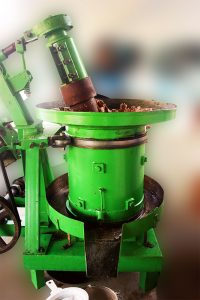Sunflower Oil: Cook with a Spoonful of Sunshine

Sunflower seed oil is one of the healthiest of oils available for cooking. It is light golden-yellow in colour and does not have a distinct flavour or taste, thus making it versatile for any type of cuisine. It is relatively heat stable and can withstand frying temperatures.
Our organic sunflowers are grown in in the Bedarahalli region of southern India.

The oil is extracted from the first press, and hence is also called Virgin oil. This process uses an electric form of the traditional Indian wooden press, called the “kachi ghani” to make the oil. The cake that remains after sunflower oil extraction is used as livestock feed.
In contrast, manufacturing of “refined” oils includes heating the mixture to very high temperatures, and using industrial solvents to extract maximum oil. This results in the breakdown of the chemicals in the oil, thus making it unhealthy. The presence of unnecessary chemicals makes it unhealthy as well. Read this article to understand why refined oils are a bad idea.
You can buy them in the United States on Amazon
In India, you can get them on Amazon.in or Bigbasket.com
Helianthus annus is the scientific name of sunflower. It grows best in fertile, wet, well-drained soil with a lot of mulch.
 The sunflower head is a cluster of thousands of florets on a modified flat stem. The outer florets have large yellow petals and are sterile. The inside florets are arranged in a spiral pattern on a disc and these develop into seeds. Sunflower seeds are a miracle food packed with healthy minerals and vitamins. They are also used to produce bio diesel. The sunflower head is a geometric marvel as the seeds are arranged in a logarithmic spiral reflecting the Fibonacci numbers on it.
The sunflower head is a cluster of thousands of florets on a modified flat stem. The outer florets have large yellow petals and are sterile. The inside florets are arranged in a spiral pattern on a disc and these develop into seeds. Sunflower seeds are a miracle food packed with healthy minerals and vitamins. They are also used to produce bio diesel. The sunflower head is a geometric marvel as the seeds are arranged in a logarithmic spiral reflecting the Fibonacci numbers on it.
Organic cold pressed sunflower oil is known to effectively cut down cholesterol due to the combination of fatty acids found in it. It is a great source of linoliec acid, which cannot be synthesised by the human body. It also has high amounts of Vitamin E which benefits your skin. It has the ability to enhance energy and immunity levels, improve your skin health, avert cancer, bring down cholesterol, give relief in arthritis and guard against asthma.

Sunflower, the flower that always faces the sun, stands for positivity, loyalty, constancy and adoration. For farmers, it is symbolic of bounty and harvest. Vincent van Gogh painted an entire series on sunflowers to depict the whims and fancies of time.
History of Sunflower Oil
Sunflower was a common crop among native American tribes throughout North America. Evidence suggests that the plant was cultivated in present-day Arizona and New Mexico about 3000 BC. Some archaeologists suggest that sunflower may have been domesticated before corn.
Sunflower was used in many ways throughout the various native American tribes. Seed was ground or pounded into flour for cakes, mush or bread. Some tribes mixed the meal with other vegetables such as beans, squash, and corn. The seed was also cracked and eaten for a snack. There are references of squeezing the oil from the seed and using the oil in making bread.
Non-food uses include purple dye for textiles, body painting and other decorations. Parts of the plant were used medicinally ranging from snakebite to other body ointments. The oil of the seed was used on the skin and hair. The dried stalk was used as a building material. The plant and the seeds were widely used in ceremonies.

The above image shows the journey of the sunflower, from its origins in North America, to Europe during the times of the Spaniards, from where it spread to Russia, and then came back to America during the 1800s in the bags of Russian immigrants to Canada, where it was then grown on a commercial scale in the 1920s, and then re-exported to Europe in the 1980s 🙂
I had mentioned earlier that it lends itself well as an oil for frying. So here is a frying recipe for you to enjoy. Yummy vegetable fritters in chickpea flour, called “Pakoras”. Best accompanied with some chai.
– Sujatha
